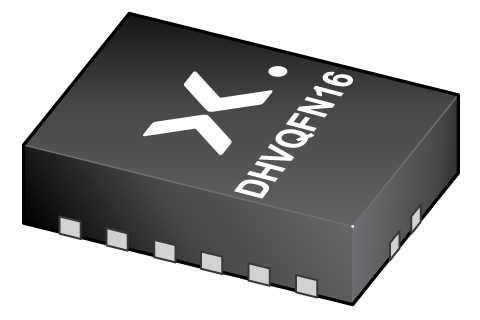Orderable parts
| Type number | Orderable part number | Ordering code (12NC) | Package | Buy from distributors |
|---|---|---|---|---|
| 74HC4053BQ | 74HC4053BQ,115 | 935273668115 | SOT763-1 | Order product |

Register once, drag and drop ECAD models into your CAD tool and speed up your design.
Click here for more informationTriple 2-channel analog multiplexer/demultiplexer
The 74HC4053; 74HCT4053 is a triple single-pole double-throw analog switch (3x SPDT) suitable for use in analog or digital 2:1 multiplexer/demultiplexer applications. Each switch features a digital select input (Sn), two independent inputs/outputs (nY0 and nY1) and a common input/output (nZ). A digital enable input (E) is common to all switches. When E is HIGH, the switches are turned off. Inputs include clamp diodes. This enables the use of current limiting resistors to interface inputs to voltages in excess of VCC.
Wide analog input voltage range from -5 V to +5 V
Low ON resistance:
80 Ω (typical) at VCC - VEE = 4.5 V
70 Ω (typical) at VCC - VEE = 6.0 V
60 Ω (typical) at VCC - VEE = 9.0 V
Logic level translation: to enable 5 V logic to communicate with ±5 V analog signals
Typical ‘break before make’ built-in
ESD protection:
HBM: ANSI/ESDA/JEDEC JS-001 class 2 exceeds 2000 V
CDM: ANSI/ESDA/JEDEC JS-002 class C3 exceeds 1000 V
Multiple package options
Specified from -40 °C to +85 °C and -40 °C to +125 °C
Analog multiplexing and demultiplexing
Digital multiplexing and demultiplexing
Signal gating
| Type number | Configuration | VCC (V) | Logic switching levels | RON (Ω) | RON(FLAT) (Ω) | f(-3dB) (MHz) | THD (%) | Xtalk (dB) | Power dissipation considerations | Tamb (°C) | Rth(j-a) (K/W) | Ψth(j-top) (K/W) | Rth(j-c) (K/W) | Package name |
|---|---|---|---|---|---|---|---|---|---|---|---|---|---|---|
| 74HC4053BQ | SPDT-Z | 2.0 - 10.0 | CMOS | 200 | 20 | 170 | 0.02 | -60 | very low | -40~125 | 89 | 10.8 | 57 | DHVQFN16 |
| Model Name | Description |
|---|---|
|
|
| Type number | Orderable part number, (Ordering code (12NC)) | Status | Marking | Package | Package information | Reflow-/Wave soldering | Packing |
|---|---|---|---|---|---|---|---|
| 74HC4053BQ | 74HC4053BQ,115 (935273668115) |
Active | HC4053 |

DHVQFN16 (SOT763-1) |
SOT763-1 | SOT763-1_115 |
| Type number | Orderable part number | Chemical content | RoHS | RHF-indicator |
|---|---|---|---|---|
| 74HC4053BQ | 74HC4053BQ,115 | 74HC4053BQ |
|
|
| File name | Title | Type | Date |
|---|---|---|---|
| 74HC_HCT4053 | Triple 2-channel analog multiplexer/demultiplexer | Data sheet | 2024-03-21 |
| AN11044 | Pin FMEA 74HC/74HCT family | Application note | 2019-01-09 |
| AN90063 | Questions about package outline drawings | Application note | 2025-10-22 |
| SOT763-1 | 3D model for products with SOT763-1 package | Design support | 2019-10-03 |
| hc4053 | 74HC4053 IBIS model | IBIS model | 2022-10-21 |
| Nexperia_package_poster | Nexperia package poster | Leaflet | 2020-05-15 |
| DHVQFN16_SOT763-1_mk | plastic, dual in-line compatible thermal enhanced very thin quad flat package; 16 terminals; 0.5 mm pitch; 3.5 mm x 2.5 mm x 0.85 mm body | Marcom graphics | 2017-01-28 |
| SOT763-1 | plastic, leadless dual in-line compatible thermal enhanced very thin quad flat package; 16 terminals; 0.5 mm pitch; 3.5 mm x 2.5 mm x 1 mm body | Package information | 2023-05-11 |
| SOT763-1_115 | DHVQFN16; Reel pack, SMD, 7" Q1/T1 product orientation | Packing information | 2025-10-24 |
| 74HC4053BQ_Nexperia_Product_Reliability | 74HC4053BQ Nexperia Product Reliability | Quality document | 2025-03-20 |
| hc | HC/HCT Spice model | SPICE model | 2022-02-17 |
| HCT_USER_GUIDE | HC/T User Guide | User manual | 1997-10-31 |
If you are in need of design/technical support, let us know and fill in the answer form we'll get back to you shortly.
The Nexperia Longevity Program is aimed to provide our customers information from time to time about the expected time that our products can be ordered. The NLP is reviewed and updated regularly by our Executive Management Team. View our longevity program here.
| Model Name | Description |
|---|---|
|
|
| Type number | Orderable part number | Ordering code (12NC) | Status | Packing | Packing Quantity | Buy online |
|---|---|---|---|---|---|---|
| 74HC4053BQ | 74HC4053BQ,115 | 935273668115 | Active | SOT763-1_115 | 3,000 |
|
As a Nexperia customer you can order samples via our sales organization.
If you do not have a direct account with Nexperia our network of global and regional distributors is available and equipped to support you with Nexperia samples. Check out the list of official distributors.
The interactive datasheets are based on the Nexperia MOSFET precision electrothermal models. With our interactive datasheets you can simply specify your own conditions interactively. Start by changing the values of the conditions. You can do this by using the sliders in the condition fields. By dragging the sliders you will see how the MOSFET will perform at the new conditions set.